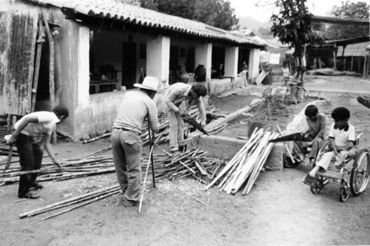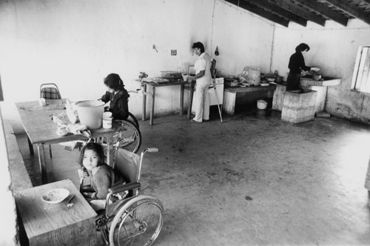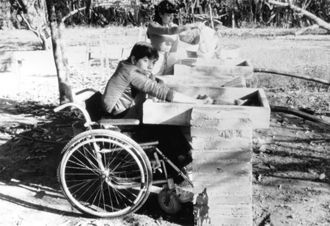Hesperian Health Guides
Chapter 51: Adapting the Home and Community
Contents
ADAPTING THE HOME
The kind of adaptations needed in the home will partly depend on the kind of disability a child has, the severity of the disability and the age and size of the child. Adaptations for a child with loss of vision are very different than those for a child who is paralyzed and uses a wheelchair. A child who is completely dependent will need aids and adaptations to help the family care for him and move him—especially as he gets older and heavier. However, the child with disabilities who can do a lot for herself may be helped by adaptations that make self-care and work in the house easier.
The kinds of adaptations needed will also depend on the local living situation, style of house, and customs. For example:


The “lift” can be made with a platform so that the whole wheelchair can be lifted. But if the house is small and people cook and eat at floor level, it may be best to leave the wheelchair outside.
Adaptations for the child who is learning to walk and balance
HAND RAILS
These can be fixed to the walls and furniture. If necessary, pathways with rails can be put up so that the child can walk with support almost anywhere in the house, and also outside to the latrine (toilet) or garden (see "Adaptations for farm work and gardening").
Before attaching hand rails firmly, have the child test them with a temporary rail at different heights to find out what works best. As the child grows, you may need to place the rails higher. Or you may want to remove rails little by little to help the child improve her balance and walk more independently.

MATS
For the child who only rolls or crawls, some kind of straw mat or rug will help protect her knees and skin, and will help her stay cleaner (if floors are of dirt).


| The “model home” in PROJIMO is a guesthouse. It has features that make it easier to care for a person with disabilities, or for a person with disabilities to care for herself and do housework. Visiting families can find out what is useful for their child and can adapt their own home. Here PROJIMO workers split wild cane to make screens to keep out the animals |  |
Home adaptations for wheelchair riders
FLOORS

THANKS!
PLEASE!
For almost any person with disabilities—but especially those who use wheelboards or scooters with small wheels, the floor should be as smooth and firm as possible (but not slick or slippery). Packed, smoothed clay-and-cow-dung surfaces (as used in India) work well. Cement is even better for long-lasting use of a trolley or wheelchair. Although expensive, a smooth cement floor makes getting around a lot easier.
DOORWAYS

wide
Make all doorways extra wide. Remember, your child will grow and may need a bigger, wider wheelchair.
In a house that already has very narrow doorways, be sure the wheelchair you buy or make is narrow enough to fit through easily. Most commercial chairs are much wider than necessary, especially for a child.
Try to avoid any rise or bump at the doorway. If it already has a raised sill and you cannot remove it, build a small ramp to go over it. This will be especially helpful for children with weak arms and hands.
BATHROOM OR OUTHOUSE (LATRINE)

low rack
doorway
KITCHEN AREA

The stove, work areas, and tables should be as low as possible, but high enough so that the legs of the wheelchair rider can fit under them.
 |
|
| The cooking and eating area in the model home at PROJIMO has a lot of adaptations. |
BED OR COT
The bed or cot should be the same height as the wheelchair for easier transfer.

WASHING AREA (outdoor)
 cement washstand with ridged bottom |
 Outdoor washing area at PROJIMO— designed for work from a wheelchair. |



